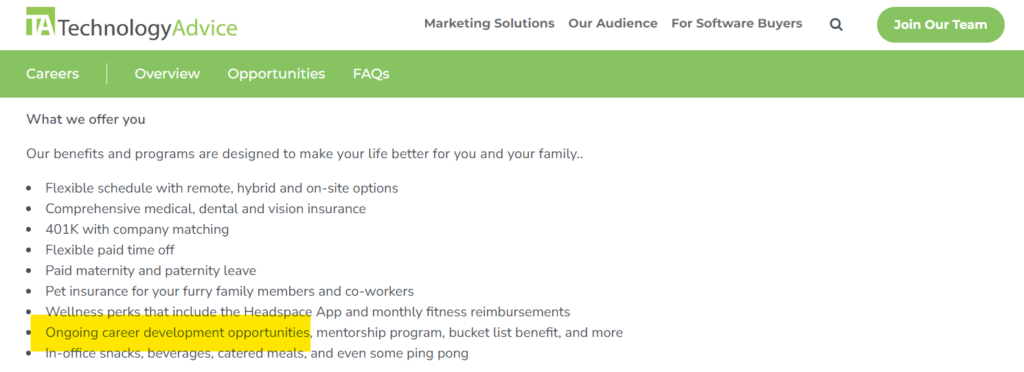By understanding employee training statistics and how they relate to your company, you set yourself up to grow and properly train your employees. This leads to better engagement, higher productivity, and overall employee retention. Additionally, you can use employee training trends to evaluate employees who are ready to advance into a leadership role.
Key Takeaways
- Setting career goals can increase employee engagement during training by four times.
- Employees leave companies that don’t provide growth opportunities and training resources.
- 92% of candidates will choose a company with learning and development opportunities over those that do not offer them.
Below are 26 current trends in employee training and development. We’ve broken them down into subcategories—recruiting trends, new hire training, employee performance metrics, employee engagement data, leadership development, and employee retention.
Overall Company Training Statistics
Understanding how training can impact your employees and overall business performance is crucial.
1. 50% of companies in the US do not have a formal training program.
50% is a large number of companies that are not training their employees properly. When you choose fly-by-your-seat training, you get spotty results. By adding a formal training program to your company, you have more control over the type of learning given to your employees and can track progress and update accordingly.
(Source: Research)
2. Pulse surveys can improve employee training and increase return on investment (ROI).
According to a survey conducted by D2L, companies find it challenging to keep learners engaged during training (54%). Based on this statistic, businesses can use pulse surveys to identify areas where employees are interested in learning more and where knowledge gaps exist. This helps to skill-train employees and keep them engaged in their training, which ultimately leads to increased productivity and a greater ROI for the company.
(Source: D2L)
3. 39% of organizations stated that a lack of budget kept them from adopting a learning and development program.
Budget can be a huge factor in developing a thriving learning and development program. Companies with a small budget will typically have a smaller training program. But that doesn’t mean your program will be unsuccessful. By honing in on exactly what your employees need to learn, you can tailor your program to your budget without decreasing learning.
(Source: Research)
Recruiting Trends
Small businesses put a lot of effort into recruiting to find the best talent for their workforce. When recruiting, it is especially important to highlight your company culture, including training and development opportunities. Candidates who believe a company cares about their advancement are more likely to apply for your open positions.
4. Most job seekers are looking for opportunities to learn new skills.
In a recent job market analysis, 90% of those surveyed said that the opportunity to learn new skills was important when looking for a new job. If your company offers training opportunities, be sure to let job seekers know—it can sweeten the deal when they are ready to make a decision.
(Source: Aerotek)
5. 92% of job seekers will choose a company with learning and development opportunities over a company that doesn’t offer them.
In addition to a flexible work environment, job seekers are looking for companies that offer training and upskilling opportunities to enhance their careers. When you create your job ads, be sure to include learning and development as one of the perks of working at your company.
(Source: IMC)

Like TechnologyAdvice, it’s important to mention career development opportunities in your job ads. (Source: TA)
6. 57% of workers want to update their skills.
Employers can benefit from knowing that more than half of US workers want to update their current skill level. Having a learning and development program already in place will help you attract workers who want to increase their knowledge and skills. This helps you hire eager talent.
As part of your onboarding process, all new hires should be trained in both their job responsibilities and the company culture and expectations. This sets your new hires up for success and growth within your company.
(Source: SHRM)
New Hire Training
As part of your onboarding process, all new hires should be trained in both their job responsibilities and the company culture and expectations. This sets your new hires up for success and growth within your company.
7. 2 out of 5 (43%) new hires said their training needed to be updated.
When you recycle new hire training year after year, you end up with outdated material that leaves the new hire unsatisfied with their onboarding experience. According to the 2023 State of Employee Experience survey conducted by ELearning Industry, this means that your new employees’ creativity and enthusiasm may wane once they sign on with your company.
(Source: ELearning Industry)
8. 8 in 10 people say learning adds purpose to their work.
Based on this statistic, companies need to make learning part of their new hire training. This will help your new employees feel connected to their work, leading to increased productivity and engagement.
(Source: LinkedIn)

The Marriott Hotel in New York group trains its new hires. (Source: Hotel Business)
9. 62% of new hires believe they are not properly trained on company products and services.
Part of your onboarding process should be to make sure your new employees understand your company and the products or services being sold. This training should be more in-depth than just a PowerPoint presentation that tells them about your company. Go deeper by showing the new hire your products and how they work, or allow them to shadow someone in your company who best understands your services.
(Source: BambooHR)
10. 71% of new hires feel prepared for their jobs because of the training they receive.
To set your new hires up for success, it’s important to train them properly. You can’t just put an employee into a role and expect them to succeed—no matter how many of their previous jobs were similar roles. The way each company operates and the systems used will be different from job to job, even if the job title is the same.
(Source: ASE)
Employee Performance Metrics
How well your employees are trained has a direct impact on their performance. If you leave it up to the employee to prepare and understand their role in your company, they may lack the drive to succeed. However, if you adequately train your employees, their performance will undoubtedly increase.
11. Company executives believe learning and development should be focused on upskilling at scale (53%) and driving employee performance (50%).
Companies remain heavily focused on training employees to develop new skills to increase employee performance. Make sure your training opportunities for your employees enhance the skills they already possess and help develop future skills. This will help with cross-training employees and preparing those who may be close to moving into leadership roles.
(Source: EdX Enterprise)
12. 59% of employees equate adequate training with greater performance.
When employees feel they are properly trained, then they can perform their jobs better. Those who lack sufficient training may become stagnant, and their performance levels will drop. Create training programs that highlight skills that need improvement. This will automatically increase performance in that skill.
(Source: LinkedIn)
13. Engaged employees have a higher level of productivity and performance within companies.
When employees are not given an opportunity to grow, they may feel stuck in one place. This will lead to less engagement with their job and could result in the employee quitting. By giving them learning opportunities, they can increase their skill level, potentially move up in your company, and have increased job satisfaction.
(Source: Gallup)
14. 34% of HR professionals measure training success on the actual productivity of employees, while 36% use performance reviews.
One of the best ways to know if your training program is working is how your employees perform. If they have increased levels of productivity following training, then you know the training was successful. Additionally, you can evaluate employees during performance reviews to see how their training equates to performance.
(Source: LinkedIn)
Employee Engagement Data
Engaged employees are generally happier employees. You can use training, such as group bonding exercises, to help employees engage with one another.
15. 20% of employees say they don’t have time to participate in training sessions, despite their love for learning.
When your employees feel stressed and overwhelmed with work, they are less likely to want to participate in any training that is outside their everyday workload. To circumvent this, give your employees downtime in their working day that allows them to work on learning opportunities and grow in their roles.
(Source: ELearning Industry)
16. 63% of employees believe company training is a way to bond with their team.
Instead of just providing individual training for your employees, consider holding group training sessions where team members can collaborate to learn and understand the information. This helps your employees bond together over a common task and learn to work together to solve problems.
(Source: ELearning Industry)

When your employees train in teams they build deeper relationships with their co-workers. (Source: Adobe Stock)
17. Employees who set career goals are 4x more likely to be engaged with learning and training opportunities
Career goals are important for not only the company but also for individual employees. When goals are set, individual employee training can be personalized to help the employee meet those goals. This will increase the employee’s engagement with their training opportunities.
(Source: LinkedIn)
18. 92% of employees believe well-planned training programs have a positive impact on their overall engagement.
When you introduce training programs to your employees, don’t just throw together something at the last minute. When you properly plan and implement well-designed training programs, your employees will be more engaged with the content; resulting in higher levels of learning.
(Source: LinkedIn)
Leadership Development
Every employee should have a development plan that highlights the path they will take in their careers with your company. You must also train these employees throughout their careers so they are ready to move into leadership roles when the need arises.
19. More than 45% of high-developing companies train their leaders in diversity and inclusion.
Leaders who embrace diversity, equality, and inclusion (DE&I) in the workplace are not just trend followers but visionaries shaping a more equitable future. Because of this, it’s important that you train your leaders in DE&I initiatives. This will set your organization on a path toward innovation, collaboration, and sustainable success.
(Source: Wilson Learning)
20. High-performing companies prioritize character development when training leaders.
Character training helps your leaders focus on the behaviors they exhibit. These usually include soft skills like communication, dealing with conflict, and problem-solving. Leaders who know how to communicate with their employees are more successful and able to balance the good and bad within their teams.
(Source: Training Magazine)
21. 87% of leadership and development leaders say businesses can show value by helping employees gain skills to move into different roles.
When it comes to your leaders, helping them gain skills that allow them to advance in their careers is critical. This also adds value to your organization as training your employees shows you care about their growth and success in your business.
(Source: LinkedIn)
22. 70% of businesses expect employees in leadership roles to take personal responsibility for their own learning and development.
Considering that your leaders are your most important asset, it is surprising that so many companies expect these leaders to gain knowledge from training on their own. While there are natural-born leaders, many must be trained to handle the impact of such a position. Don’t leave it up to your leaders to know the areas they need training—this should be part of your company’s key goals.
(Source: Training Magazine)
Employee Retention
One of the main goals of any company is to have a culture where employees feel valued and praised for their contributions. When your employees are happy, they are more likely to stay with your company long-term.
23. Gen Z workers value learning for career advancement
A staggering 53% of Gen Z workers (those born after 1996) say that through learning, they feel they can advance in their careers. This makes them eager to learn, making training more effective.
(Source: LinkedIn)
24. The top reasons employees leave their companies are due to a lack of growth opportunities (18%) and inadequate training resources (12%).
If you fail to provide your employees with a growth path and training resources to help them achieve their career goals, it could result in them leaving your company. Your goal is to retain successful employees. You can do this by providing them with the learning opportunities that help them succeed.
When considering the costs involved with replacing an employee, it is wise for companies to incorporate proper training into their culture. Training your employees (part of employee management) to enhance the skills needed to perform their jobs can save you in potential replacement costs.
(Source: Work Institute)
25. 45% of employees say they would stay with their current company if they were given additional learning and development opportunities.
When employees feel their career path has grown stagnant, they typically start looking for other opportunities where they can grow and thrive in their careers. However, by providing training and learning opportunities, you can ensure your employees are continuing to thrive in their roles.
(Source: LinkedIn)
26. Investing in career mentoring and coaching can boost employee retention.
Empowering your workforce by not only providing training opportunities but also setting them up with peers for mentoring and coaching can help properly train them to succeed. This in turn will lead to increased employee retention.
(Source: LinkedIn)

A peer mentor can provide firsthand knowledge to employees who need additional skills training. (Source: Adobe Stock)
Frequently Asked Questions (FAQs)
Employee training is only as effective as the materials provided for learning. By investing in a training program, you can ensure your employees are equipped with the knowledge and skills they need to be successful in their job roles.
Employee training should begin with the onboarding process for new hires. From there you can train employees in regular intervals, such as once a year, or when a skill or need arises.
Every employee training plan should include information about the company and culture and specific skills training to help your employees grow in their roles.
Personalized artificial intelligence (AI) learning is the future of employee training. It enhances the learning experience with the use of intelligent technology that uses machine learning and language processing to personalize learning.
Bottom Line
It is proven that a well-developed training program has a positive impact on hiring, employee engagement, leadership potential, and employee retention. Plus, by including learning and development opportunities in your job ads you can attract top talent. You can use the above statistics to help improve your training program and create a strong, skilled workforce.
References: Research, D2L, Aerotek, IMC, SHRM, ELearning Industry: State of Employee Experience 2023, LinkedIn: Workplace Learning Report 2024, BambooHR, ASE, EdX Enterprise, Gallup, LinkedIn, Wilson Learning, Training Magazine, Work Institute